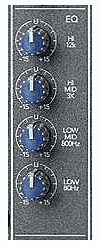
Generally speaking, with mics used for vocalists and pastors, you will want to turn down the low frequency for those channels to reduce the tendency for low end rumble, and also to help speech intelligibility.
The mid-range control is not on most home stereos, and therefore creates the most questions. This is compounded when deciding what frequency to set the filter.
This filter works the same as High and Low, turns down to the left and turns up to the right. It effects, unless adjustable, (next time) usually about a two-octave range of frequencies.
So what that means is in this case we can select at what frequency the center of the adjustment will occur.
The range here can be as low as 100 Hz and go up as high as 3,000 Hz, or 3 kHz. This range of frequencies is where most of what we hear happens. A bass player is playing from about 30 Hz up to about 240 Hz, while a bass singer is in the 55 Hz to 500 Hz.
All vocalists, from the lowest to the highest, will range from about 55 Hz to about 1,700 Hz (1.7 kHz), all within the area of this particular EQ control. This is where we can either make the speaker (person talking) or singer sound crisp and clear, or dull and lifeless.

So, how do you get comfortable using these controls? It is not as difficult as it sounds, and it can be fun if you like your calling and have a little time.
Just plug in a mic and start to talk into it. Set all the controls straight up to “0”, no cut, no boost.
While talking begin to cut then boost the high control just to see what if any effect it has on your voice. Do this with each control just so you can hear what happens in each frequency range.
There is no magic here, and not much to fear unless you like to listen at real high levels. I suggest you do this as well. Turn it up until you get some feedback, best done while others aren’t present, and see which frequency range cuts out the feedback.
Also play some music through the system and do the same cuts and boosts. You will be surprised at what you hear and don’t hear, and will also start to become more comfortable using these controls the next time you are “live” and getting the results you want.
